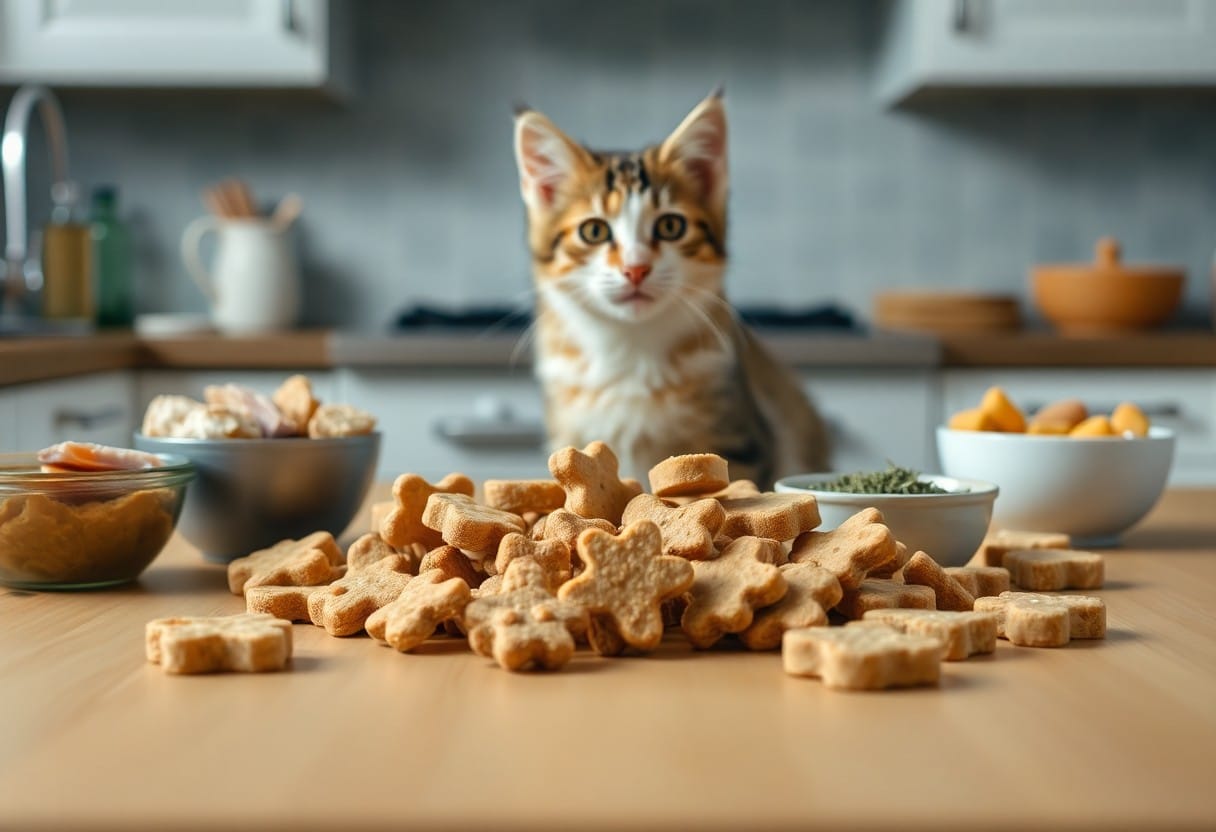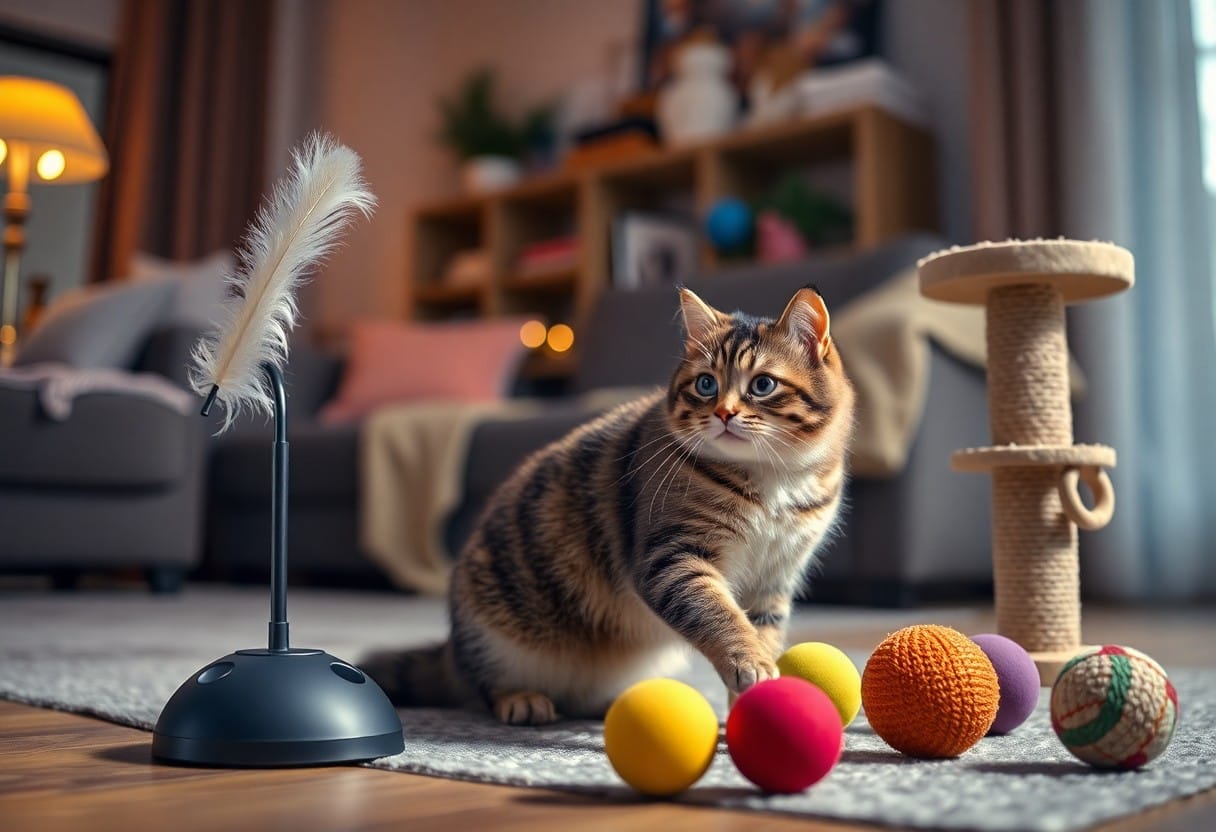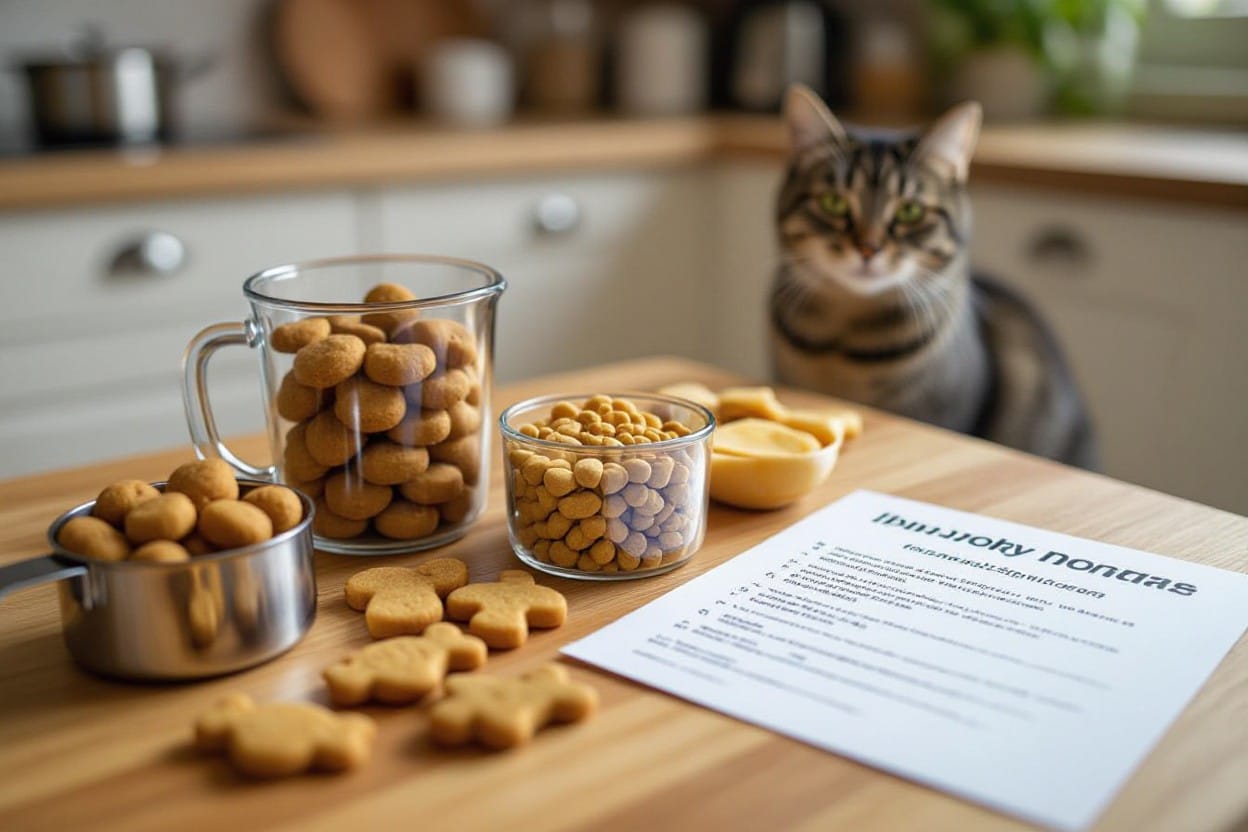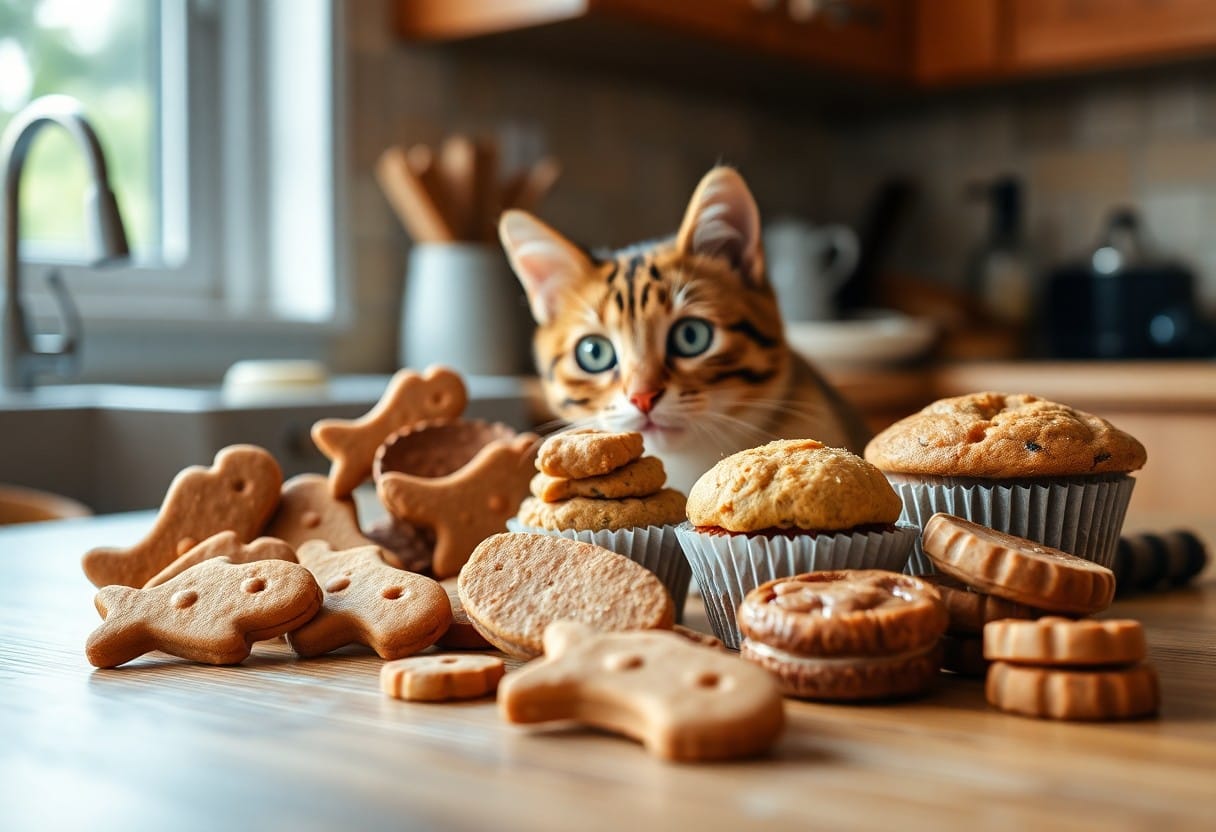It’s time to elevate your cat’s diet with homemade treats that not only satisfy their taste buds but also contribute to their overall health. By utilizing simple ingredients from your kitchen, you can create nutritious snacks that can help prevent common health issues in cats, such as obesity and dental problems. In this post, you’ll discover a variety of recipes designed to enhance your feline friend’s wellness while treating them to something delicious. Let’s transform your kitchen creations into purr-fect delights for your furry companion!
Key Takeaways:
- The book offers a variety of healthy homemade treat recipes that cater specifically to the nutritional needs of cats, ensuring they receive beneficial ingredients.
- Each recipe highlights the importance of using fresh, quality ingredients, which can improve a cat’s overall health and wellness.
- Included are tips on food safety and preparation methods, making it easy for any cat owner to create safe and tasty treats at home.
Wholesome Ingredients That Fuel Feline Health
Feline health fundamentally relies on the quality of the ingredients you choose for their meals and treats. Incorporating natural, nutrient-rich ingredients acts as a powerhouse for your cat’s vitality. Opt for lean proteins like chicken, turkey, or fish, as they provide necessary amino acids crucial for muscle development. Adding a variety of vegetables like pumpkin and carrots contributes fiber, while vitamins and minerals can enhance coat quality and digestive health. Overall, focusing on whole, unprocessed elements will pave the way for a healthier, happier feline companion.
Superfoods for Cats: What to Look For
Superfoods are the secret treasures you can include in your cat’s diet that are high in nutrients and health benefits. Key options to consider are blueberries for antioxidants, spinach for iron, and chia seeds for omega-3 fatty acids. These superfoods help combat oxidative stress and support heart health while boosting the immune system. Incorporating small amounts of these ingredients into homemade treats can drastically elevate your cat’s nutritional intake while making treat time special.
Common Human Foods: Safe vs. Toxic
Knowing which human foods are safe for your cat is necessary in keeping them healthy. Safe options include small amounts of cooked chicken, plain pumpkins, and certain fruits like blueberries and cantaloupe. On the flip side, some foods are toxic and should never be fed to your feline. Garlic, onions, chocolate, and grapes can cause serious health problems. Always vet any new additions to your cat’s diet to ensure they are suitable and safe for your four-legged friend.
Many pet owners mistakenly think that all human food is safe for their cats, but the reality couldn’t be more different. While cooked meats like chicken and fish can be delightful for your cat, foods like onions and garlic are harmful; they can lead to conditions such as hemolytic anemia. Chocolate, even in small quantities, contains theobromine, which is toxic to cats. Grapes and raisins are also known to cause kidney failure. Always check reliable resources before introducing any new human food, ensuring your cat’s health remains a top priority.

Crafting Nutritious Treats: Recipes You Can Trust
Delicious doesn’t have to mean unhealthy, especially when creating homemade treats for your cat. The recipes you’ll find here are crafted with your feline’s well-being in mind, ensuring they not only enjoy their treats but also receive beneficial nutrients. Below are three standout recipes that combine taste, nutrition, and ease of preparation, making them perfect for your little companion.
Savory Chicken Bites: High-Protein Goodness
Savory Chicken Bites are packed with high-quality protein, a key ingredient for your cat’s muscle health and energy levels. Using plain, cooked chicken without any seasoning, simply shred the meat and mix with a binding agent like pureed pumpkin or egg. Bake these tiny morsels until they’re lightly golden, and you’ll have a delectable snack that your cat will adore.
Tuna Delights: A Fishy Feast for Cats
Tuna Delights are a delightful way to satisfy your cat’s cravings for seafood. Mixing canned tuna (in water, not oil) with a little oat flour and egg creates a creamy batter that you can bake into crunchy treats. These fishy nuggets provide omega-3 fatty acids, promoting a healthy coat and heart.
What makes Tuna Delights especially appealing is their simplicity and the overwhelming ‘fishing’ aroma that will have your feline friend eager for a taste. Just using a can of tuna allows you to whip up this batch quickly, ensuring freshness and quality in every bite. Consider adding a sprinkle of catnip for an added allure—it’s a culinary experience your cat won’t soon forget!
Pumpkin Paws: A Fiber-Rich Snack
Pumpkin Paws deliver a fiber-packed punch that keeps your cat’s digestive system running smoothly. By incorporating canned pumpkin into the recipe, you not only enhance flavor but also add vital nutrients like beta-carotene. Combine the pumpkin with oat flour and a hint of cinnamon for a wholesome snack that supports gut health.
Pumpkin is renowned for its positive effects on cats’ digestion, especially for those prone to hairballs or constipation. With a simple mix of ingredients followed by baking, these treats can be shaped into adorable paw prints, turning snack time into playful fun. Offering Pumpkin Paws regularly can make a noticeable difference in your cat’s overall health and well-being.
Boosting Immunity and Digestion: Treats with Purpose
Crafting treats that offer health benefits can enhance your cat’s overall well-being. Focusing on immunity and digestion, you can create recipes that not only satisfy your feline’s palate but also support their bodily functions. Using the right balance of natural ingredients, your homemade treats can become a powerful addition to their daily diet.
Tailored Treats for Sensitive Stomachs
For cats with sensitive stomachs, opting for easily digestible ingredients is key. Recipes using pumpkin, sweet potatoes, or oatmeal provide gentle fiber while avoiding irritants. Foods like boiled chicken or fish can deliver high-quality protein without upsetting their digestive systems, making it possible to pamper your picky eater without the stress of gastrointestinal issues.
Immunity-Reviving Ingredients to Include
To bolster your cat’s immunity, incorporate specific ingredients known for their health benefits. Nutrient-dense superfoods like broccoli, blueberries, and spinach are packed with antioxidants, while chicken liver provides imperative vitamins A and B12. Additionally, adding a sprinkle of turmeric known for its anti-inflammatory properties can further enhance their immune response, making homemade treats not just tasty but also functional.
Integrating these immunity-reviving ingredients into your treats can have lasting benefits. For example, blueberries contain vitamin C, which helps in collagen production and tissue repair, while spinach provides iron and helps oxygenate the blood. Incorporating just a pinch of turmeric can amplify these effects, promoting overall health and vitality. Experimenting with these ingredients allows you to create a diverse range of delectable treats that not only cater to your cat’s taste buds but also fortify their defenses, ensuring they live their happiest life possible.
The Importance of Balance: Treats as Part of a Healthy Diet
Integrating treats into your cat’s diet can enhance their overall well-being when managed correctly. Treats should play a role in your cat’s diet without overwhelming the important nutrients they receive from their primary meals. Providing a balanced approach ensures that your furry friend enjoys these flavorful bites while still maintaining their health. The right proportions of homemade treats can even foster positive behavioral responses and health benefits over time.
How to Integrate Homemade Treats into Daily Meals
To successfully incorporate homemade treats, consider using them as an occasional reward during training sessions or as a supplement to their main meals. A good rule of thumb is to allocate treats to no more than 10% of your cat’s daily caloric intake. This way, your cat enjoys the benefits of both their regular diet and the delicious flavors of your homemade creations while avoiding overindulgence.
Ensuring Nutritional Balance: Tips for Pet Owners
Prioritizing nutritional balance requires careful consideration of what goes into your cat’s food, especially with homemade treats. Utilizing fresh ingredients like lean proteins, vegetables, and whole grains can create a wholesome snack that complements their regular meals. Ensure that you avoid dangerous ingredients like garlic, onion, and excessive fats. Consulting with your veterinarian can also help you track your cat’s nutrient intake and tailor treats to their individual health needs. Assume that maintaining a well-rounded diet will contribute significantly to your cat’s longevity.
- Fresh ingredients are key to creating nutritious treats.
- Avoid dangerous ingredients such as garlic and onion.
- Consult your veterinarian for personalized dietary advice.
- Monitor your cat’s caloric intake to prevent obesity.
Ensuring that your feline’s diet remains well-rounded is not just about maximizing their enjoyment of treats, but also about providing them with the important vitamins and minerals they need. By selecting ingredients that are high in protein and fiber, you can easily whip up treats that support muscle repair, digestive health, and overall vitality. Moreover, regular tracking of your cat’s dietary habits will empower you to fine-tune both their meals and treats for optimum wellness. Assume that this proactive approach will foster a healthier, happier pet companion.
- Opt for high-quality protein sources in treats.
- Incorporate fiber-rich ingredients for digestive support.
- Keep treats within the 10% calorie guideline.
- Regularly monitor your cat’s weight and activity.
Transforming Your Cat’s Relationship with Food
As you introduce homemade treats into your cat’s diet, you’ll notice a remarkable shift in their relationship with food. By creating delicious and healthy options, your feline friend not only enjoys what they are eating but also benefits from increased nutrition. The excitement of anticipation before meal times can deepen the bond you share, making mealtime an engaging and delightful experience for both of you.
The Joy of Bonding Through Homemade Meals
Preparing meals for your cat can transform your interaction with them. The act of cooking is a simple yet profound way to show your love and care. When you share these homemade delights with your cat, a sense of joy and connection develops that strengthens your bond. Imagine the tail wagging and purring as your feline eagerly awaits their special homemade treat. This shared experience fosters trust and affection, enriching your companionship.
A Shift in Perception: Treats as Healthy Rewards
Changing how you view treats can lead to a healthier lifestyle for your cat. By crafting nutritious options, treats evolve from mere indulgence to valuable rewards that reinforce positive behavior and contribute to overall health. Shifting from unhealthy commercial treats to wholesome, homemade alternatives allows your cat to perceive treats as a part of a balanced diet rather than simple snacks.
For instance, consider integrating ingredients like pumpkin or sweet potatoes into your recipes. These components not only enhance flavor but also pack in fiber and vitamins. As you experiment with new recipes, your cat will learn to associate treats with wellness and fun rather than just empty calories. You can even condition your cat to respond positively to specific behaviors, rewarding them with these nutrient-rich treats. This holistic approach to treats benefits their overall health while transforming snack time into a meaningful ritual that both you and your pet cherish.
Conclusion
So, as you explore the delightful realm of homemade treats with “From Kitchen To Cat Bowl – Delicious Recipes For Homemade Treats That Boost Health,” you empower yourself to enhance your cat’s well-being through nutritious and tasty snacks. By incorporating simple, wholesome ingredients, you create treats that strengthen your bond with your feline friend while promoting their overall health. Embrace your culinary skills and enjoy the rewarding experience of watching your cat thrive on your homemade creations.
Q: What types of ingredients can I use for homemade cat treats?
A: When making homemade cat treats, it’s necessary to choose cat-safe ingredients that also provide health benefits. Common ingredients include cooked chicken, turkey, or fish as the main protein source. You can also incorporate vegetables like pumpkin or sweet potatoes, which are great for digestion. Additionally, using whole grains like oats or brown rice can add fiber. It’s best to avoid fillers and artificial additives, focusing on natural ingredients that support your cat’s health.
Q: How can I ensure the treats I make are healthy for my cat?
A: To ensure your homemade cat treats are healthy, start by using nutritionally balanced recipes specifically designed for cats. Pay attention to portion sizes, as treats should only make up a small portion of your cat’s overall diet. Additionally, consider your cat’s dietary needs and any potential allergies; for example, some cats may be sensitive to certain proteins or grains. Incorporating superfoods like flaxseed or fish oil can also enhance the nutritional profile of the treats.
Q: How should I store homemade cat treats to keep them fresh?
A: To maintain the freshness of your homemade cat treats, store them in an airtight container in a cool, dry place. If your treats contain perishable ingredients, it’s best to refrigerate them to prevent spoilage. For long-term storage, consider freezing treats in small batches; simply thaw them before serving. Always check for any signs of spoilage or unusual odors before giving treats to your cat.
















